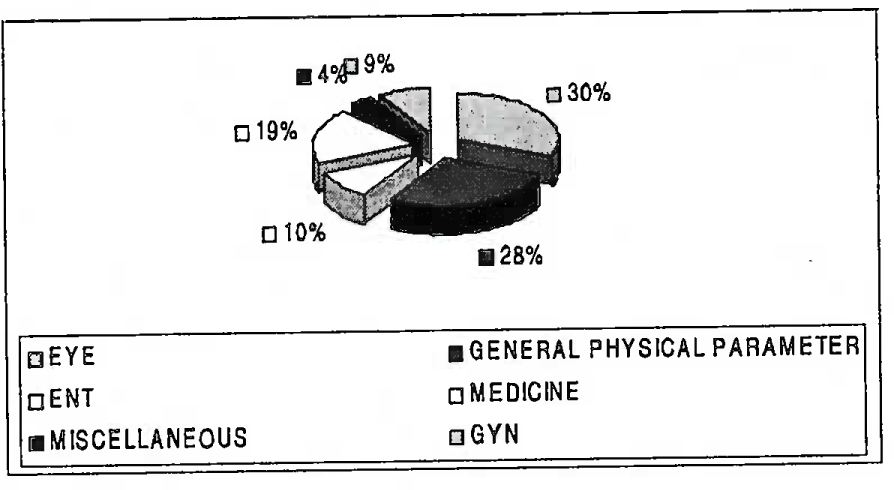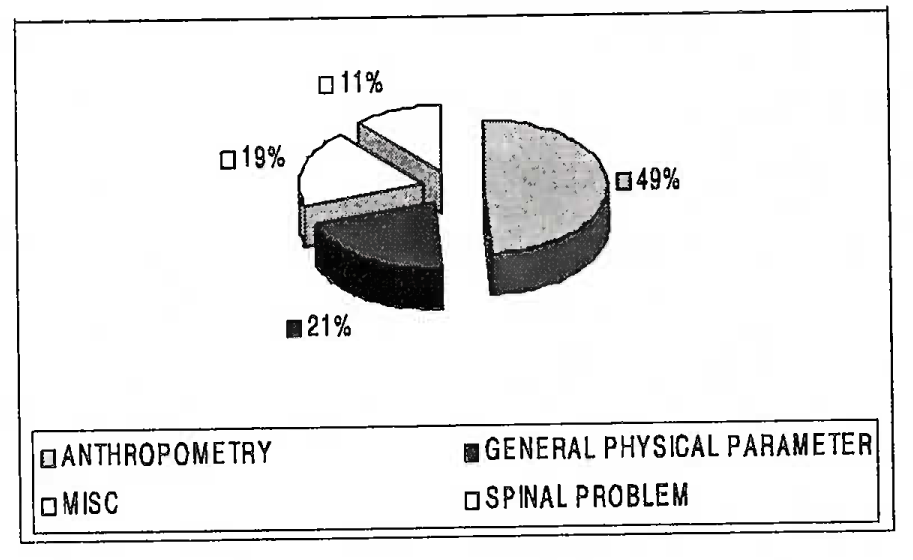Translate this page into:
An analysis of initial medical examination of women cadets in the Indian Air Force
Abstract
Medical standards for entry into the Indian Air Force (IAF) as commissioned officers are predominantly the same for women candidates as that for males. The initial medical examination for such candidates is carried out at the Institute of Aerospace Medicine (IAM) and Air Force Central Medical Establishment (AFCME). There has been no study on the causes of rejection of women candidates during their initial medical examination. This study was therefore carried out to analyze the initial medical examination of women candidates conducted at IAM. Medical records maintained at the Medical Evaluation Centre at the Institute were accessed to get the details of medical examination of women candidates from the year 1997 to 2005. A total of 331 candidates (245 for ground duty and 86 for aircrew duty) underwent their initial medical examination at IAM during this period. An overall rejection rate of 55 % for aircrew and 30 % for ground duty candidates was observed. Differences were observed, both in the percentage of rejections and disabilities between aircrew and ground crew. While anthropometric incompatibilities like substandard leg length was the major cause of rejection among aircrew candidates, obesity and refractive errors were the major cause of rejection among ground crew candidates.
Keywords
Medical disabilities
fitness
women candidates
The Indian Air Force (IAF) opened her doors for women officers in early nineties by enrolling women in both aircrew and ground crew duties. Women aircrew are employed at present in helicopter and transport streams. Ground duty officers are commissioned in both technical and non-technical branches.
A stringent medical examination of the candidates is carried out at entry. The medical standards for this initial medical examination are laid down in IAP4303 [1] and are predominantly the same as male candidates. The standards for aircrew duties are expectedly more stringent than those for ground duties.
Initial medical examination for selected women candidates is carried out at the Institute of Aerospace Medicine (IAM) and Air Force Central Medical Establishment (AFCME). Periodic analysis of data on medical examination can provide information regarding the nature of the disabilities causing rejection. It also provides inputs on the adequacy of the medical policies governing such medical examination. This study was carried out to analyse the data on the initial medical examination of women candidates in the IAF.
Material and Methods
The medical records of all initial medical examination of women candidates are maintained at Medical Evaluation Centre [MEC] in IAM. These records were available from Jan 1997-2005 and were accessed for this study.
Results and Discussion
A total of 331 women candidates (Ground duty N=245, Aircrew N=86) underwent their initial medical examination at this Institute during the period of study. The mean age of the candidates was 21.8 ± 0.9 years.
Of the 245 candidates for ground duties, 73 (30%) were found unfit whereas out of the 86 candidates for aircrew duties, 47 (55%) were rejected on medical grounds. Every candidate undergoes the full medical examination irrespective of any disability being detected at any stage of the examination. Some candidates had more than one disability. A total of 81 disabilities among ground duty candidates and 53 among aircrew candidates were found.
Majority of the unfitness of ground duty candidates were on account of ophthalmic (31%) and general physical conditions (28%). The details of the disabilities causing rejection and their proportional distribution are shown in Table 1 and Fig 1 respectively. Refractive errors (n=20) and obesity (n=19) were the two major causes of rejection.
Among the aircrew candidates, substandard anthropometric measurements were the leading cause of rejection (n=26, 49%) followed by obesity, which formed 21 % of the total disabilities. The disabilities detected in aircrew candidates are given in Table 2 and the system wise percentage of the disabilities is given in Fig 2. As is evident from Table 2, a lot of spinal disabilities (n=6, 11%) were detected among aircrew candidates.
There were no significant trends identifiable in the pattern of or causes of unfitness between the two groups over the period of study.
The initial medical examination is intended to preclude from acceptance those individuals who are either unfit or likely to break down under the stress and strain of military service. It also ensures that each candidate fulfils the medical qualifying standards for her flying or ground career. The standards for fitness are the same for all branches except for aircrew whose visual acuity and anthropometric requirements are higher. Aircrew candidates are also required to undergo a full spine radiograph, which is not required for ground duty candidates.
Anthropometric standards reflect the stipulated anthropometric requirements for military aircraft of the IAF. For selection for aircrew duties, minimum stature of 162.5 cm, sitting height of 81.5 cm and leg length of 99 cm is mandatory [1]. Substandard anthropometric measurements was the major cause of rejection of aircrew candidates, accounting for 49% of the total disabilities. The minimum height required for aircrew duties is mentioned in the advertisements, which solicit their presentation for the examinations. It is surprising that in spite of this announcement, there were some candidates with substandard height. In a similar study on the initial medical examination of aircrew candidates for Air Force by Girish et al. anthropometric incompatibilities accounted for 19.9% of the total disabilities leading to unfitness [2].
| Disability | No. | (%) |
|---|---|---|
| EYE | 25 | (30%) |
| Substandard vision | 20 | |
| Squint | 2 | |
| Miscellaneous | 3 | |
| GENERAL PHYSICAL PARAMETER | 23 | (28%) |
| Obesity | 19 | |
| Underweight | 3 | |
| Substandard Stature | 1 | |
| MEDICINE | 15 | (19%) |
| Anaemia | 5 | |
| Eosinophilia | 3 | |
| Miscellaneous | 7 | |
| ENT | 8 | (10%) |
| Deviated Nasal Septum | 4 | |
| Substandard hearing | 2 | |
| Hypertrophied Tonsils | 1 | |
| Myringitis granulation | 1 | |
| GYNAECOLOGY | 7 | (9%) |
| Ovarian cyst | 5 | |
| Bartholin cyst | 1 | |
| Prolapse | 1 | |
| MISCELLANEOUS | 3 | (4%) |
| Communited fracture of tibia | 1 | |
| Fracture both bones of forearm | 1 | |
| Haemorrhoids | 1 | |
| UNFIT | 73 | |
| DISABILITIES | 81 |
| Disability | No. | (%) |
|---|---|---|
| ANTHROPOMETRY | 26 | (49%) |
| Substandard height & leg length | 26 | |
| GENERAL PHYSICAL PARAMETER | 11 | (21%) |
| Obesity | 11 | |
| MISCELLANEOUS | 10 | (19%) |
| ECG abnormalities | 2 | |
| Ovarian cyst | 1 | |
| Others | 3 | |
| Cervical rib | 1 | |
| Substandard vision | 1 | |
| Adnexal mass | 1 | |
| Anaemia | 1 | |
| SPINAL DISABILITIES | 6 | (11%) |
| Unilateral incomplete | ||
| sacralization | 3 | |
| Spondylolysis | 2 | |
| Schmorls node | 1 | |
| UNFIT | 47 | |
| DISABILITIES | 53 |

- System wise split up of disabilities: Ground duty candidates

- System wise split up of disabilities: Aircrew candidates
Stature, per se, is more of an administrative requirement. Females in general are shorter than their male counterparts. The minimum stature requirements for the aircrew in the IAF are the same for both male and female candidates. This could be the reason for the high rejection due to anthropometric disabilities found in this study.
A candidate is declared unfit on account of obesity if his/ her weight for height and age is more than 20% above ideal. Obesity formed 21% and 23% of the total disabilities for aircrew and ground duty women candidates respectively. This rate of prevalence of obesity may reflect the societal trends on obesity.
Towards minimising these rejections, it may be worthwhile to have the weight for height and age charts available on the IAF website. All aspiring candidates can access this to know their status. This will then give them sufficient time to reduce their weight and be within the required standards before they appear for the initial medical examination.
A candidate must possess normal visual acuity, ocular muscle balance, full field of vision and normal colour perception. Visual defects and ophthalmic conditions were the major cause of rejection and hence the importance of a thorough and accurate eye examination cannot be overemphasised. Visual defects formed 31% of the cause for ground duty candidate rejection. Similar proportions of ophthalmologic disabilities causing medical unfitness at entry have been reported in other studies on NDA cadets [2] and Jordanian Air Force [3].
The human spine is subjected to various stresses during flying. Pre-existing spinal deformity can get aggravated due to these stresses and lead to backache. Therefore, aircrew candidates are subjected to full spinal radiograph to detect spinal disabilities that are not compatible with flying duties. Spinal anomalies formed 11% of total disabilities in this study. Of these, congenital spinal anomalies and degenerative spinal conditions were equal in number. Similar proportions of degenerative and congenital spinal disabilities have been reported in a recent study [2].
Conclusion
While ophthalmic disabilities and obesity were the leading causes for unfitness among ground duty applicants, substandard anthropometric measurements and obesity were responsible for the highest rejections among aircrew applicants. No significant trend or pattern was noticed in the disabilities causing unfitness over the period of this study.
References
- Manual of Medical Examinations and Medical Boards IAP-4303. (3rd Ed (revised)).
- Retrospective analysis of initial medical examination of aircrew applicants at IAM.
- Medical causes of dismissal in candidates selection for pilots in Royal Jordanian Air Force.






